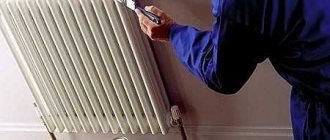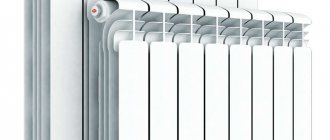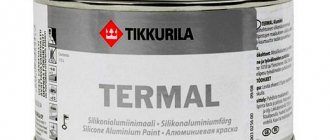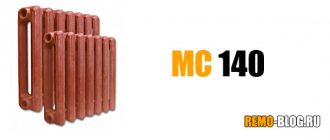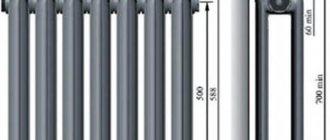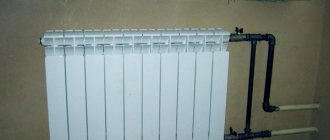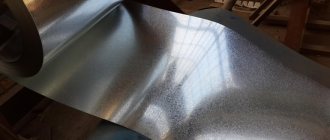Which batteries can be painted and which ones shouldn’t?
Before considering the variety of paints, let's talk about whether all types of radiators are recommended to be painted. So, first, decide on the type of your heating battery, because this determines whether it can be painted, or whether it is better to abandon this idea:
- It is not advisable to paint modern aluminum and bimetallic batteries. Initially, they are painted at the factory with durable powder paint, which, thanks to the peculiarities of the technology, lies perfectly evenly. If you decide that the original color of the radiator (usually white) does not suit the interior of the room, and you want to repaint it, then you are unlikely to be able to achieve the same perfectly even coating. Even if you remove the battery and paint it horizontally. In addition, an additional layer of paint will reduce heat transfer, which is a significant disadvantage for regions with harsh winters.
- It is not advisable to paint plate radiators, especially those with a large surface area. They are installed in houses where there is a network with increased internal pressure. They have low convection but high heat transfer. As for our question, due to its design, it is difficult to properly paint a heating radiator of this type, especially with a brush. If this is really necessary, then you will have to remove it, clean it thoroughly (which is very difficult) and paint it in a horizontal position with a spray gun or car paint in the form of a spray. But even this way you may not achieve a perfect application. There may be missing areas in hard-to-reach places, because the elements of the plate radiator are located too close to each other.
Important! Manufacturers recommend painting only the removable metal linings, and only cleaning the rest of the dirt and dust.
- Convectors and pipes with fins (especially with frequent aluminum fins) are not painted, since painting can negatively affect their heat transfer. The design of the convector, in addition to the heat source, includes a removable casing. It can be painted to enhance the overall look.
- It is recommended to paint cast iron batteries. This is not difficult to do, different paints are suitable and they do not affect the heat transfer. The choice of colors is huge.
- It is possible to paint steel panel radiators. But there is a nuance here - you won’t be able to evenly cover the surface of the battery with a brush. You will have to use car paint in a can, and it is advisable to paint in a horizontal position.
Which batteries can be painted?
It’s worth clarifying right away that painting heating radiators is not possible in all cases. First of all, it is advisable to perform this operation for cast iron radiators, a thick and uneven layer of paint on which not only spoils the exterior of the battery, but also greatly impairs the quality of heat transfer. The second type of batteries that can and should be painted are convectors, made in the form of a bent riser pipe with fins pressed onto it.
If you own modern models of radiators with aluminum sections, then it is better to abandon the idea of painting. Of course, you can paint it, but you will have to apply many layers of paint, and you are unlikely to achieve the expected effect. The fact is that the battery is painted with a brush, and this method is by definition worse than the factory one, so it is better to leave new battery models alone and, if necessary, cover it with a decorative screen.
Preparing to paint the radiator
To do this, the following three states of the heating radiator can be taken into account:
- The old paint layer does not have any cracks or chips. This means that the previous one was completed as correctly as possible, so in this case you can proceed directly to applying a fresh coating.
- If the surface of the battery has small areas with chipped and peeling paint, this means that these areas require sanding to obtain a smooth surface, and only then painting.
- Provided that the old coating has come off almost completely, painting radiators can only be done with serious preparatory work, which will require the use of a brush equipped with iron bristles, or a special washing solution with the addition of a certain amount of alkali.
Preparing cast iron batteries for painting
The preparation of batteries and pipes begins with removing the old paint layer. There are 2 simple methods for cleaning radiators:
- Mechanical - using a steel brush or an attachment to an electric drill. The coating is removed down to the metal surface; for this reason, this option will require a lot of time and physical stress on the part of the performer. One drawback is the difficulty of working in inaccessible areas. A special attachment for an electric drill facilitates the cleaning process, and it also makes it possible to thoroughly treat the entire area of the device, including in hard-to-reach areas.
- The chemical method involves the use of special compounds based on acids and thinners that reduce the adhesion of the layer to the base metal. The surface is carefully coated in accordance with the instructions until the paint softens deeply. Then the old coating is removed with a spatula, grinder or stiff brush.
Types of dyes for batteries
Many types of paints, or rather individual representatives of these types, meet the above requirements. After all, most paints are designed for temperatures below +80 °C. Therefore, manufacturers produce special modifications of their products.
In general, painting batteries yourself can be done with the following types of paints:
- Acrylic enamels. They are based primarily on organic solvents. This feature causes the release of a solvent odor during the application of the acrylic mixture to the battery. However, once it dries, the smell becomes history and the room is left with a radiator with a nice glossy shine. This shine lasts for many years.
- Alkyd enamels. They are known for their excellent resistance to wear and high temperatures. The range of colors of these enamels is very large, so many people choose such paints. These paint solutions also emit an unpleasant odor as they dry. It can also be felt in cases where the heating radiator gets very hot.
- Water-dispersion paint. Many experts note that such paint for radiators is optimal. This is because it does not upset the nose with a specific smell, and the drying time is very short. True, not every water-based mixture is suitable for batteries. Only those that have the appropriate designation on the packaging are suitable. Its color can be any.
- Oil paints. They were very popular in the past. Known for emitting a solvent odor upon drying and long curing times.
It is worth adding that radiator paint may contain elements that resist corrosion and improve adhesion (they are constantly used in primers). Such mixtures have different colors and do not require primers or cleaning the radiator from corrosion.
At least that's what the manufacturers note. In practice, it is better to remove rust from the heating device and use a primer. The processes are lengthy, but the results are reliable. This is often noted in various videos.
Painting the battery throughout the heating season
Anyone who has painted heating radiators knows that it is not easy.
Preparation
The first step is removing the old paint. Due to the fact that the design of the battery makes many of its places difficult to reach, it is not possible to clean it the old-fashioned way using a metal brush.
A soldering iron or hot air gun will not work. Since in the first case the structure can be damaged, and in the second it is simply useless.
Paint remover can remove paint even in hard-to-reach places
Of course, this method also has its drawbacks, but it still gives the best results. The remover works on the principle of a solvent. It penetrates the paint layer, softens it and then scrapes off the old paint quite easily with a putty knife or metal scraper.
Among other things, the remover does not damage metal or wood, so it can be used before batteries
.
Beautiful batteries will decorate the kitchen
How to paint batteries:
The process of painting radiators
- apply wash;
- remove old paint;
- rust must be sanded off;
- treat the battery with a degreaser (white spirit or slightly alkaline solution);
- if necessary, apply a primer;
- After drying, you can apply the main color.
Think of your own interesting radiator decor
- Batteries should only be painted when they are cold
. Therefore, it is better to postpone all work to a time when the heating season has already ended. If the need arises in the autumn-winter season, turn off the valves and wait until it cools completely. - If you have to apply paint to warm radiators, use a spray can or apply a very thin layer
. The whole difficulty of applying paint to a hot surface is that brush marks remain. In addition, if the paint is changed, the batteries will become stained. - Radiators can only be connected after the paint has completely dried.
.
Interesting colored batteries will become a highlight of the kitchen
How to choose the right paint for heating radiators:
Preparing batteries for painting
The process of preparing radiators for painting is a very important stage of work, as it is necessary to perform several tasks:
- One of the tasks is to increase the adhesive properties of materials, as well as protect the metal from corrosion.
- If the batteries are old, covered with several layers of paint, cleaning them is necessary to increase heat transfer.
It is recommended to carry out all work both on preparing surfaces and painting them at the end of the heating season. An exception may be the use of paints and primers designed for application to hot surfaces.
So, preparing radiators for painting consists of several operations:
- Cleaning surfaces from dust and greasy deposits. Dust accumulated inside the sections is removed using a vacuum cleaner with a crevice nozzle or a narrow brush. You can also use the wet cleaning method using water and detergents. If grease stains have formed on the battery, which often happens in kitchen conditions, you can remove them with dishwashing detergent. If necessary, apply a damp cloth to heavily soiled areas, under which the greasy stains will soften and will be easier to clean off.
Cleaning cast iron radiators using a metal brush attachment mounted on a grinder. The work is dirty and tedious, but, alas, without it the quality will not be the same...
- Removing rust and old paint . Next, new batteries must be cleaned of rust, and old batteries must be cleaned of numerous layers of paint. There are two cleaning methods - mechanical and chemical.
— The mechanical method is more labor-intensive and will take quite a lot of time. It is carried out using a metal brush mounted on a grinding machine or in the chuck of an electric drill. However, this method is only suitable for cast iron radiators. Modern batteries made of thin sheet steel or non-ferrous metals can be seriously damaged by a hard wire brush. In any case, you should work at low speeds. The paint on the surface of the batteries must be completely removed.
— Another cleaning method is the use of chemical compounds , with the help of which paint or rust is washed off from surfaces. The compositions are produced in the form of a solution, paste, gel or aerosol.
Remover for removing paint from wood and metal surfaces
Each of the chemical composition options is used differently - on the packaging the manufacturer gives instructions for their use, which must be strictly followed. For example, paste-like substances are applied to surfaces using a brush with natural bristles, after which the battery is covered with plastic film for a period determined by the manufacturer. The exposure time can vary from twenty minutes to several hours. The paint should soften, after which it is removed from wide surfaces with a spatula, and its remains are removed mechanically using a metal brush.
Aerosol versions of washes are convenient to use, since when sprayed they penetrate into the most inaccessible places in the radiator sections. The principle of operation of these compositions is comparable to any type of remover - the paint is softened, then removed with a spatula and brush.
However, it should be warned that chemical compounds are not harmless. They have a pungent, pungent odor, so the room where they are used must be well ventilated. In addition, it is necessary to protect the respiratory tract with a respirator, and your hands with protective gloves. When choosing this cleaning method, it is necessary to purchase compounds that indicate that they are safe when applied to metal.
To ensure that the paint adheres well to the surface, it is recommended to pre-paint by applying a layer of primer.
- Radiator priming . The next step is applying primer to the cleaned surfaces. This treatment is intended to prevent the appearance of corrosion areas, as well as to create optimal conditions for the adhesion of painting materials. The composition chosen for priming must be intended for metal surfaces and be compatible with the paint that will be used to paint the radiators.
If you purchase domestically produced paint, then GF-021 primer is well suited for it. When using paint compositions from foreign manufacturers, you can use Sigma or Dulux primer.
The final stage of painting begins after the primer layer has completely dried.
Paints come in different colors
Painting of radiators and pipes begins with the selection of substances with which to paint the metal. If the photo shows an amazingly beautiful painting of radiators, this does not mean at all that the artist managed to achieve this effect after the first layer of paint. Painting batteries is a rather complex process consisting of several stages. There are various means of painting heating radiators on the modern market. Before answering the question of how to paint a battery or studying the process of painting a battery captured on video, you need to figure out what kind of paint can be used to do all this. The easiest option for selecting paint is to purchase it at a special shopping center that sells radiators and heating pipes.
Paint for heating devices.
Specialist consultants will tell you what type of paint is suitable for painting the heating radiator. Cast iron radiators and other heating system elements are painted with abrasion-resistant paints. Batteries should only be painted with paints that are resistant to aggressive environments. In the video showing how to paint radiators, you rarely see the can of paint itself. And this is an important point for those who decide to paint the batteries themselves. Battery paint must be heat-resistant. The absence of toxicity of dyes is one of the most important points. The batteries heat up, and if the paint applied to them is toxic, this directly threatens the life and health of people in the building.
Acrylic
There are two types of paints for heating batteries. Acrylic enamels are based on organic solvents. If you paint heating radiators with them, you won’t have to worry about the appearance of the heating system for a long time, since acrylic enamels have the ability to retain their shine and aesthetic appearance for a long time. They are an attractive option for those who prefer a variety of colors when painting heating radiators. However, acrylic enamels have a significant drawback: an unpleasant odor that remains even after painting the radiators is finished. Moreover, when the radiators heat up, the unpleasant odor returns and causes discomfort.
Spray paint.
Water-dispersed
When deciding what to paint radiators with, experts usually recommend water-dispersed paints. They do not have a specific smell. Heating radiators painted with them look aesthetically pleasing. Water-dispersed paints have a wide range of colors. If you don’t know what to paint batteries with, it’s better to choose them right away
In order not to make a mistake when purchasing, you need to pay attention to the cans in which the paint is sold. They must have special markings indicating that the paint is suitable for painting heating radiators and pipelines
It is possible to paint radiators with oil paint, but it is practically not used for these purposes.
How to choose the right paint for radiators
A wide range of different brands leads to the fact that buyers are faced with the problem of which paint to choose.
Therefore, when choosing, you must pay attention to whether the enamel meets the following requirements:
- lie flat on metal products;
- Provide protection against rust and corrosion damage;
- Withstand elevated temperatures;
- Maintain the original color for a long time.
When choosing paint, it is important to consider the material from which the radiator is made.
In addition, it is also necessary to take into account what material the batteries and radiators are made of. After all, they can be made from a variety of metals, as well as their alloys. Experts recommend following several tips:
- For devices made of steel, aluminum and bimetallic composition, it is better to use acrylic or alkyd paints;
- Any type of enamels, except oil-based, are well suited for cast iron batteries. However, in order for the substance to lay down in an even and thin layer, it must be mixed with a thinner;
- It is better to refuse to use oil paints, even of the most famous brands, because they very rarely perform protective and decorative functions at the same level as others
Features of preparation
There are two ways to remove a layer of old paint:
The first involves using a spatula or round metal brush attached to an electric drill. Using a spatula requires physical effort as you need to move it with your hands. Moreover, it will take quite a long time to wash off the paint. This must be taken into account when calculating the total painting time. The disadvantage of this option is that it is difficult to reach the bottom of thin cracks.
A round metal brush attached to an electric drill is a more versatile method.
The chemical method involves the use of special solvents or fatty acids. They treat the entire area of the battery and cover the treated surface with film. Then they rest. The duration of rest is indicated on the packaging. It may be different. During this time the paint becomes soft. Of course, it does not slip (which would be very good), but its removal with a spatula, a grinder or a wire brush becomes very easy.
It is worth remembering that solvents emit substances harmful to the body. Therefore, when using a chemical method, you need to protect your hands with construction gloves, your respiratory tract with a gauze bandage, or even better, a respirator.
The surface of the radiator, cleared of paint, is treated with sandpaper. They work especially carefully in places where there is corrosion. It needs to be completely removed. Only a pure metallic sheen should remain.
For degreasing, use white spirit or any other alkaline solution.
The radiator is primed with a solution that meets the following requirements:
- is a product of the same manufacturer that produced the paint. In this case, the primer and paint work best together;
- contains substances that can resist corrosion.
Choosing the Ideal Battery Paint
It is important to determine which paint is best to transform radiators. There are a number of requirements that the paint applied to batteries must meet
Heat resistance of the paint is required at least one hundred degrees; abrasion resistance and non-toxicity are also required, since the batteries are regularly cleaned and the radiator itself heats up. The greatest heat resistance is achieved by paint containing metal powder instead of coloring pigments.
There are special paints for radiators on sale; many people use water-based enamels and heat-resistant varnishes. The paint you choose must be suitable for coating metal and match the primer. Good compounds are durable, do not change color, and can protect themselves from corrosion.
Glossy shine and long-term color fastness are ensured with acrylic enamels based on organic solvents. But they smell quite strong when applied.
Water-dispersed paints dry quickly, but it is important to select them carefully, choosing special types. After painting with alkyd enamels, the uniformity of the coating is guaranteed, it will be durable and resistant to influences
However, the smell can be observed not only during the painting process, but also some time after drying, released from heating.
Color selection
The decision on what color is best to paint the radiators is up to the owners. A wide range of products and various formulations are now available. White enamels and silver are considered classic. Some choose colors in accordance with the interior, lighting, general style of the apartment and design features. Gold and bronze shades, subtle patterns and designs look unusual.
If the look of your old radiators no longer pleases you, then you can try to breathe new life into them through experiments
- The quality of painting of cast iron batteries also largely depends on how well they are prepared. A smooth foam roller of small diameter is optimal as a tool for applying paint, and a brush is useful in hard-to-reach places. To decide for yourself how to paint most conveniently, you should think about removing the batteries. The radiator, separated from the pipes, can be coated with the composition on all sides, so there will be significantly fewer hard-to-reach places. However, this method does not always pay off; sometimes it is easier to paint the battery more thoroughly without wasting time on removing it. It all depends on the specific circumstances and the shape of the radiator.
- A very important factor is the temperature of the surface to be painted: the radiator must be cold. To the question “is it possible to paint hot batteries?” any specialist will answer unequivocally: this cannot be done. The most convenient moment is when there is no heating season. But the beginning of the heating period will not be a hindrance if you close the valves on the radiators, stopping the access to boiling water. It is enough to wait until they cool completely to start painting. If paint is applied to a hot radiator, it will lie unevenly, swell, and various stains and stains will probably form. Moreover, you can turn on the heating only when the paint is completely dry.
Painting radiators and heating pipes requires care and precision. It is good to use brushes, small rollers, and spray cans. It is optimal to use a spray gun to process the previously removed battery, then all hard-to-reach areas will be perfectly painted. It is from those places that are least accessible that you should start painting
It is important to maintain a uniform layer thickness, otherwise the color may further differ in different areas. It is recommended to start painting from the top, then accidental drips will not spoil the lower part. You need to cover the entire battery with the composition, not limited to its front part.
It is more effective to apply paint in two thin layers, and wait until the first one has completely dried before painting again. Then there will be no drips, and it’s easier to achieve perfect evenness with thin layers.
Is it possible to paint hot radiators and how to do it?
Heat-resistant enamels for cast iron batteries are produced on the basis of resins (alkyd, acrylic, silicone), water dispersions (acrylic and silicone); there are also powder paints, but their use requires special equipment; painting is done in a factory.
For painting at home with your own hands, acrylic compositions (water-soluble or organic solvent-based) and alkyd are popular.
Alkyd
Alkyd-based enamels contain pigments, special additives, and a thinner - pentaphthalic or glypthal varnish. A common alkyd enamel is pentaphthalic PF-115. The compositions are affordable, have good coverage, are durable, wear-resistant, and have a wide range of colors.
Photo 1. Alkyd enamel for cast iron heating radiators with a plastic effect from.
The disadvantage of enamels is the drying time and the unpleasant odor that persists in the room for several days; it can appear at high temperatures of the coolant; enamel cannot be called harmless.
Reference! Alkyd enamel is applied in 2 layers to a pre-primed surface with a brush or using a spray gun.
Water-based acrylic enamel dries quickly, the paint layer is smooth and even, like plastic. It is odorless, does not burn, is safe and environmentally friendly, and has high adhesion to metal.
The disadvantage of acrylic water-dispersed enamels is their instability to abrasives (the surface cannot be cleaned with powders).
Photo 2. Acrylic glossy enamel for cast iron batteries PROFI VD-AK-1179 dries quickly and leaves no odor.
In addition to acrylic resin, the composition includes pigments, additives and a solvent – white spirit. The enamel forms a durable and stable coating; the paint can be applied to surfaces previously treated with acrylic or alkyd. The layer is durable and does not turn yellow over time.
The disadvantage is the unpleasant odor and the drying time - the painted surface dries in about 8 hours, the second layer is applied a day later.
If the manufacturer's instructions do not indicate the possibility of applying the composition to old paint, then radiators require pre-washing, cleaning of the old paint layer, then priming and painting in 2 layers.
Work is carried out wearing protective glasses, a respirator and gloves.
Attention! A set of protective clothing is the best protection against harmful dust and chemicals. To protect the space around the radiator from accidental splashes, protect the surfaces with plastic film, cardboard or paper.
Wiping the radiator
https://www.youtube.com/watch?v=O2LHdXtcOh5
Use a brush or vacuum cleaner to remove accumulated dust and small debris.
All internal and external surfaces are thoroughly washed with detergent.
Remove the old paint layer in one of 3 ways:
- washed off with a chemical composition;
- removed mechanically using a drill and special attachments - brushes;
- soften the old paint with a hair dryer or a torch and remove it with a spatula.
Chemical compositions for removing old paint (removal) are produced in the form of liquids or aerosols.
Important! When choosing a washing solution, pay attention to the composition: it should include components that prevent corrosion.
The softened paint layer is removed with a spatula, or a rag will do. Removing paint without softening is done using a drill with a brush attachment with metal teeth. After cleaning off the old paint, the surface is dusted: manually - with a brush, broom or vacuum cleaner.
The surface of the radiators is sanded down to metal. This work can be done manually with sandpaper, but cleaning with a sanding machine is faster and better.
The dust-free surface is degreased if it is planned to paint with alkyd compounds - gasoline or white spirit; when painting with acrylic - acetone.
Primer
Before priming, flaws and large irregularities are puttied. Use metal putty designed for high temperatures (from 80 °C) (epoxy, automotive). The dried layer is sanded, dusted and degreased.
The primer is selected in accordance with the paint. Some manufacturers allow the use of paint diluted with water or solvent (5% by volume) instead of primer. This point should be described in detail in the instructions for the paint.
Coloring
To properly paint a battery, you need flute brushes: medium width with a straight handle and narrow with a curved handle.
Attention! Instead of a flute with a curved handle, you can make a pad from a piece of foam rubber attached to a wire. It is easy to bend the wire at the desired angle, and it is easy to paint all hard-to-reach places.
The primed metal base practically does not absorb paint.
Therefore, to avoid drips, take a little paint onto the brush and carefully distribute it over the surface in a thin layer.
The spray paint can is held vertically at a distance of 30 cm from the surface, and the composition is applied in a zigzag motion.
The painting sequence is the back surfaces from top to bottom, then the top, sides and internal parts, and lastly the front side and bottom of the battery.
The second layer of paint is applied over the dried first layer.
Greetings, dear reader!
Many apartments still have cast iron radiators. This does not mean that “old”, “antiquity”, etc. and it is urgent to get rid of them. This is the simplest option. If you are not a supporter of primitive solutions and are ready to experiment, this article is for you.
Today I will try to convince you that you can make candy out of old things.
To do this, you just need to transform your heating devices and you can do it yourself. I’ll tell you how to paint radiators today. This is a difficult and time-consuming task, but it is worth it.
Before you decide to paint the batteries in your home yourself, remember that not all surfaces are suitable for this. Look around and find out what kind of radiators you have. If the radiators are cast iron or old style with many stacked fins - go ahead!
So, the hedgehog understands that before you start painting, you need to decide what to paint with. The final result of our work will depend on what we choose. If until recently only white was used, now the color range is very wide and varied. You can not only update the appearance of your battery, but also create a unique interior of the room.
Read more: Do-it-yourself chimney damper, how to make a damper for a pipe
If you are serious about painting radiators yourself, take care of the necessary tools.
What you might definitely need:
- Knife – for removing peeling paint;
- Sandpaper, special remover or wire brush - to remove old paint;
- Paint brushes of various sizes;
- Rags – for cleaning the surface of batteries;
- Roller – small for painting.
All paints intended for painting heating devices have their advantages and disadvantages:
- Acrylic enamels - when dry, they emit a characteristic odor, but the result will please you - a glossy shine for a long time;
- Alkyd enamels have a very large selection of colors, are resistant to high temperatures, but long-term odor retention is possible.
- Water-dispersed - no odor, dry quickly. The best option.
In any case, the choice of paint is yours. But pay attention to:
- good thermal stability;
- resistance to aggressive environments;
- minimum toxicity;
- abrasion resistance.
As for the color scheme. The traditional solution is white. But use your imagination!
You can paint the batteries:
- in the color scheme of the walls;
- the predominant color in the interior;
- silver or bronze;
- color combination;
- apply drawings.
When painting radiators in a children's room, I would advise you to abandon stereotypical views. These could be butterflies, flowers, rainbow colors, etc. It all depends on your financial capabilities and imagination. Even if you have 2 colors in your arsenal, you can create an unprecedented color scheme and delight your children.
An important step in this process is preparing the battery surfaces for painting. If you need high-quality and durable painting, let's do a little work. Preparatory work is the most time-consuming. But it's worth it.
You can determine a certain sequence of preparing radiators for painting:
- We thoroughly clean the surface to be painted: remove the old layer of paint. Where signs of rust are visible, we clean them to a metallic shine. We wash away dust and dirt, remove the old paint with a spatula and wash-off solutions;
- Apply the rinsing solution to the surface of the radiator and cover with film to soften. Afterwards, the paint is easily removed using a spatula, a sander or a metal brush attached to a drill. While working, do not forget about safety measures: gloves, a respirator or a gauze bandage.
- Sand the surface of the batteries with sandpaper. Degrease with white spirit or any slightly alkaline solution.
- After the surface of the battery is well cleaned, apply an anti-corrosion primer. An alkyd-based primer would be better. When purchasing a primer, make sure that it is anti-corrosion to prevent rust from appearing again.
There are several ways to do this process:
- mechanical - using a drill and a special attachment. This also includes working with sandpaper. The process is labor-intensive but effective;
- chemical - a special paste in the form of a gel. Using a brush, apply the composition to the entire surface of the battery. If you have a multi-layer old coating, try again after 20 minutes. For intensity, use a film - cover the radiators with it. After a certain time - get to work! Use a putty knife and wire brush to remove the old paint. Sand off the remainder with sandpaper.
- We heat the metal radiator with an industrial hair dryer or blowtorch. When the temperature reaches its maximum (120-1400C), the paint will swell and begin to bubble. In this state we remove it with a spatula. I don’t recommend using this method with cast iron batteries: it takes a long time and is ineffective.
- for “pots” it’s a sad method, but it exists. We remove the radiator and throw it into the fire. After the paint burns, clean the surface with a wire brush or drill with an attachment. When the battery has cooled, we disassemble it into sections and remove the burnt gaskets on the collectors. We knock out all the accumulated garbage. When reassembling, install new gaskets. We assembled, pressed, and painted.
Nowadays you can find a large selection of paints that contain a primer and a rust converter. They are used without preparing the base of the battery, but, nevertheless, I would advise preparing it in advance. Unless of course you need quality.
Painting process.
Preparing the battery before painting
Before applying a coat of paint to the battery, you must make sure that the metal surface of the heating radiator is clean. Even new batteries need preliminary preparation: cleaning, sanding, degreasing. All this is done to ensure that the new coating is in maximum contact with the surface of the battery, providing better heat transfer. An unprepared surface can lead to a number of unpleasant consequences: cracking of the paint, disruption of the integrity of the coating layer in certain places of the radiator, etc. The same applies to pipes: before asking the question, they must also be prepared for painting and a layer of paint applied that will reliably protect the pipes from destruction.
Very often, heating systems use old radiators that have a layer of oil paint on them. If there are no defects, such batteries can be used, but it is necessary to carefully clean the entire surface of the heating device from old paint, soil and rust. The old layer of paint can be removed with sandpaper and special solvents. It’s good if you have a hair dryer among your tools - it will significantly speed up the cleaning process.
Once we have ensured that the surface of the heating radiator is perfectly clean, we can begin priming it. The primer is applied in a thin layer over the entire radiator with a brush or spray gun (the latter is relevant if we have not yet figured it out, or the heating system has not yet been installed). We will not advertise any particular brand of primer; we will only note that it should be intended for application to metal surfaces.
Preparation and tools
The procedure should be as follows:
- The surface of the radiator must be thoroughly cleaned, removing old paint from it and cleaning areas with rust. Dust and dirt should also be removed with a cloth.
- Next, you need to apply a solution to the battery to wash off the old coating, and then cover it with a film to soften it. Next, the paint can be easily removed using a construction spatula or a grinding machine equipped with (read: “How and how to remove paint from a heating radiator - means for removing old paint before painting a radiator”).
- After this, the already cleaned surface is sanded with sandpaper and degreased using any solution with a small amount of alkali.
- A primer with anti-corrosion properties is applied to the already cleaned surface, which not only prevents the appearance of harmful formations, but also increases the adhesive properties of the paint. It is best to use an alkyd primer for these purposes.
In the process of choosing what paint to paint batteries with, you need to remember that the modern construction market offers a wide range of these products, which already include a primer and a plaque-removing solution. The particular convenience of such mixtures is that they can be applied immediately, without carrying out all the above manipulations with the battery.
The stage of preparing the battery for painting can be considered key in the entire process. Any mistakes made will be visible already when applying the first layer of paint, so high-quality cleaning simplifies the painting process and ensures the durability of the new coating.
There are several ways to prepare the surface: mechanical, automatic, chemical:
- The mechanical method is the safest and most labor-intensive. Using a metal brush, the remnants of the old coating are removed, and a rag helps remove dirt and dust remaining after work.
- Automatic involves removing residues using a drill or grinder with a special attachment. In this case, you need to be very careful when removing the coating so as not to damage the radiator.
- The chemical method is the simplest, and at the same time unsafe. When processing, various compositions are used in the form of an aerosol, paste or gel, which dissolve old paint, but also harm the seals used in pipelines. And if this is hardly noticeable before turning on the heating, then the beginning of the heating season may end in a hot flood.
To clean the battery surface, you need to equip yourself with a set of tools and devices, depending on the chosen method.
You may need:
- metal brush,
- brush attachment for electric tools.
- solvent,
- sandpaper,
- primer,
- brushes
First, you should cover the surface of the floor and wall with a protective coating, for example, film, to avoid contamination during cleaning. Don’t forget about personal protective equipment (goggles, gloves, respirator).
The minimum set of equipment is represented by the following set of tools:
- brushes;
- roller;
- scraper;
- knife;
- sandpaper;
- a brush with hard bristles and a long handle;
- dye;
- solvent;
- primer;
- respirator;
- gloves.
Knowing how to properly paint radiators, the owner will select the optimal brushes, the size of which will allow work to be carried out even in hard-to-reach places. Instead of brushes, a spray bottle or a bottle of spray paint can also be used to apply the enamel more evenly.
Some owners do not know how to paint heating radiators with their own hands correctly and decide to apply enamel only to the front side. Although this solution will save time and money on consumables, it will cause many problems in the long term.
Read more: Water filters for sinks, which is the best rating 2019, which water filter to choose for an apartment, how to choose a water filter
Unpainted sections of pipes will be subject to corrosion, which will lead to failure of expensive heating devices.
When directly painting sections, you should avoid smudges, uneven layers and stains. It is recommended to first apply enamel to the internal elements of the radiators, then move to the side, and finish the job by evenly applying paint to the front side.
Painting radiators is a labor-intensive process, but very important. Knowing how to paint heating pipes and heating appliances, the owner will be able to extend the life of the home heating system and make it look aesthetically attractive. After painting, radiators should not be used in the heating system until the enamel is completely dry.
Radiator to paint
Without radiators in our climate it’s not easy
In our harsh climate, we cannot do without additional heating sources. Of course, modern technologies do not stand still and more and more often systems are installed in homes, but the batteries we are used to can still be found in many homes.
Batteries, no matter how useful they are in the winter season, are constantly subject to criticism. Their design rarely fits into the interior of the room. Such cast-iron, bulky structures are appropriate only in the industrial loft style
.
In addition to their bulky and awkward design, batteries are not easy to care for. Firstly, they perfectly collect dust, which needs to be periodically “swept out” using all sorts of tricks. But periodically they need to be painted, which is even more difficult. Let's look at how to do this correctly step by step.
Everything needs order
Calculating the amount of paint required will help you make the inscriptions on the jar where it is located. However, it is best to purchase it with a small reserve. This is especially true if the batteries have been in use for more than a year. How to paint a heating system? There are a few simple rules that must be followed for quality coloring. The paint is applied at the top first. Gradually the color goes down. The internal ceilings of the battery are painted first, then the external ones. How to paint so that the coating is high-quality and smooth? Only two layers. If you have a choice: one thick layer of paint or two thin ones, choose the second option, only it will provide uniform coverage.
Painting the battery using an aerosol can.
There is another type of painting of radiators where brushes are not required. A spray gun or spray can is an attractive option for those who are used to saving their time. In this case, a thin, uniform layer is ensured. But one of the stages of preparing the battery for painting will be to remove it so that you can apply paint to all its hard-to-reach areas. There is a wide selection of heat-resistant paint spray cans on the market. They are quite simple to use and will not be difficult for a person who has never used them.
Previously, the norm was that the battery was painted white. However, interior design fashion has begun to dictate its own rules in the painting of heating systems. Batteries in bronze and silver colors are considered a sign of vintage style. In children's rooms you can increasingly find radiators that imitate a rainbow. Small designs on batteries are considered super fashionable: ornaments, flowers, leaves, animal tracks
There are two trends in painting batteries: either they try to make them as invisible as possible, and they blend in with the color of the walls, or they are painted so that they attract attention.
https://youtube.com/watch?v=eAuZcc1f3uw
The main thing here is not to forget about a sense of proportion and that the heating system should ideally fit harmoniously into the functional and aesthetic space of the room. When performing work on preparing metal for painting and its further painting, one should not forget about safety precautions and take care of protecting hands and respiratory organs.
The need to paint the battery
So, the unit should be coated with a coloring compound if:
- purchased a new heating device. Many residents often have a question about how to paint a cast iron battery, since devices made from this material are often supplied unpainted;
- it was decided to carry out renovation work to update the interior of the premises;
- During operation, the heating device lost its normal appearance and turned into an outdated unit with peeling paint. This is especially true for traditional cast iron batteries, which were so popular in the last century.
Necessary tools for painting a battery
Knowing how to paint a heating radiator, the owner will be able to save money on purchasing new heating devices, because with the help of paint that is in harmony with the interior of the room, you can give an old cast-iron radiator an aesthetic appearance. Before painting radiators, you need to visit a hardware store and purchase the equipment necessary for painting. It is required for accurate and uniform distribution of paint, cleaning the battery and preventing smudges.
The minimum set of equipment is represented by the following set of tools:
- brushes;
- roller;
- scraper;
- knife;
- sandpaper;
- a brush with hard bristles and a long handle;
- dye;
- solvent;
- primer;
- respirator;
- gloves.
The second method of updating is dismantling the batteries
There is another way to change the appearance of batteries. It is more labor-intensive, because you have to completely remove the radiators. However, the result will be much better at keeping your batteries free of rust and dirt. First you need to reset the heating risers. After this, you will need to completely unscrew all the plugs and blind plugs, as well as remove the jumpers. Next, you need to anneal the battery (heat and hold it at high temperature) using a powerful household hair dryer. Then we disassemble the radiator into sections, using a special key for this. Don't forget to tap the radiators with a mallet to remove any rust. After this, the sections are cleaned with a wire brush.
In the next step, reassemble the battery using ordinary rubber gaskets. In this case, the size of the outer part should be slightly smaller than the end of each section. After this, install and connect the radiator to the heating network. Apply primer to the surface of the clean battery and begin painting. The operating algorithm is almost the same. The only difference is that the batteries will not be as hot as in the first case. This will make them take a little longer to dry. Often, residents of houses paint radiators immediately after dismantling them. In this case, it is possible to paint the surface both in front and behind the battery. In addition, there will be no risk of staining the wall behind the radiator.
Procedure for preparing a battery for painting
Preparing the surface for painting is a stage no less important than the painting itself. Treat it responsibly, since all the flaws and shortcomings that you make during preparation will certainly affect the quality of the paint and the appearance of the battery. Let us immediately note that all work should begin only after the end of the heating season.
Methods for removing dust and grease
First of all, the battery must be cleaned of dirt and dust accumulated in it. This can be done dry using a vacuum cleaner or brush, and wet using water and detergents. If there are layers of grease on the radiator, wash them with regular dishwashing detergent. After this, let the battery dry and proceed to the next step.
You can clean the battery from paint with a regular metal brush, but this process will take a lot of time and effort.
Now you need to remove rust and old cracked paint from the heating device. How to do it? There are two methods: mechanical, but it is quite long and labor-intensive, and chemical - simpler, but it has some nuances that will be described below.
Mechanical removal of old coatings
To remove paint mechanically, you will need a wire brush. Everything is simple here - take it in your hands and rub it until you get tired, and you get tired quite quickly, so it’s better to use a more productive method. An angle grinder with special attachments – a brush or a grinding wheel – will help you in your work.
You can quickly and effortlessly remove old paint using an angle grinder fitted with an attachment with a metal brush.
With this power tool you can remove old paint in a few hours. But be careful, do not work at high speeds, especially for radiators made of non-ferrous metals, since along with the paint you can damage the surface of the battery itself without being noticed. It is not necessary to remove the paint completely. A new coating can be applied to smooth, non-cracked areas.
How to get rid of paint using chemicals?
Now let's look at the chemical method. It consists of washing off the paint with special compounds, which come in the form of a gel, paste or aerosol. When using gel or paste products, apply them to the entire surface of the battery with a natural bristle brush, and then cover with plastic wrap for best results.
The exposure time depends on the product used and can be from fifteen minutes to several hours. The exact time is indicated on the label. After the paint has softened, remove it with a spatula and remove any remaining paint with a wire brush.
Aerosol washes are easy to apply and can be used to easily treat even hard-to-reach areas of the radiator. The principle of operation is the same as that of gel compositions - after a certain time (15-40 minutes depending on the product), the paint softens and is easily removed with the same brush. Before applying, be sure to cover surrounding furnishings, floors and walls.
Under the influence of chemicals, old paint softens and peels off. Then removing it with a spatula is not difficult.
However, chemicals are not as harmless as they seem at first glance. Firstly, they have a strong, unpleasant odor and should only be used in a well-ventilated area. It is advisable to wear a respirator and protective gloves before work.
Secondly, it is unknown how the metal will behave when interacting with an aggressive chemical composition. It may react with it, and after washing off you will find a damaged surface.
Old cast iron batteries are not afraid of modern chemicals. But here you need to be wary of something else: previously, hemp (a natural material made from flax or hemp) was used to seal radiators, but it can very easily be corroded by chemicals.
As a result, when the heating season arrives, water may splash out from all connections. Therefore, decide for yourself which method of cleaning old paintwork is best for you.
Surface priming rules
After the old paint has been removed, before you begin directly painting the radiator, you must go through a number of other procedures. To remove cracks, scratches and other minor imperfections, smooth steel or copper surfaces must be sanded. It is better to treat cast iron batteries with a wire brush.
Primer GF-021 has anti-corrosion properties and creates additional protection against rust formation
Now the radiator needs to be degreased and primed. When choosing a primer, you need to choose a product designed for metal, that has anti-corrosion properties and is compatible with paint.
For example, GF-021 primer combines well with domestic paint and varnish compositions. If an imported dye is used to paint a heating radiator, we can recommend Dulux or Sigma primer.
What tools and materials are needed for the job?
Not always and not everyone has the opportunity to change batteries. A universal way out of this situation would be to paint the radiators in any color you like. To work, you do not need to have any specific skills, but you will need to purchase some materials and stock up on tools. The purchased paint must be resistant to high temperatures. This property is necessary, since in winter the radiators of the heating system heat up and become very hot.
In addition, the composition must retain its original color over a long period of time. The lack of odor in the paint is also considered a fairly important factor, so that after work you do not have to ventilate the living areas. Before you learn how to paint, you need to understand the paints suitable for this. So, you can always find acrylic compounds in stores. They are distinguished by the absence of a pungent odor and the ability to retain their color for quite a long time.
Oil formulations are also often found in stores, but not many people buy them. This is due to the emergence of safer compounds of the first two types. All of these paints are suitable for the job to one degree or another. Painting heating radiators with your own hands using these materials will give a positive result if you follow the operating instructions and dilute the paint with solvent in the proportion specified by the manufacturer.
To get the job done quickly and not be distracted, you will need to stock up on the necessary equipment. So, you will need:
- fine-grained sandpaper;
- a knife or other sharp object for cleaning radiators;
- several brushes of different shapes:
- small roller;
- old rags.
With everything you need at hand, you can get to work
It is very important to stock up on rubber gloves and a protective mask, which will help protect your skin from stains and your respiratory tract from fumes
Choosing paint for radiators
Batteries must be painted with special paints that meet certain requirements. They must be resistant to high temperatures, not corrode and not change color during operation. Most often, the following types of coatings are used for painting radiators:
- Alkyd enamels. They are highly resistant to abrasion and can withstand heating up to 90°C. But they take a long time to dry, have a pungent odor and are toxic because they are produced using organic solvents. In addition, they often turn yellow and in some cases may crack.
- Acrylic enamels based on aqueous solvents. They are practically odorless and safe for humans. Dries within 40 minutes and retains color until the next painting. They must be applied only to a primed surface, which prevents contact of the aqueous solvent with the metal, which can cause rust to appear through the paint layer.
- First of all, the surface to be painted must be well prepared. If necessary, remove old paint using a solvent and a spatula. Next, the surface of the radiator is sanded with sandpaper, thereby removing all irregularities and creating a rough layer that improves the adhesion of new paint. After this, use a soft brush to carefully remove all dust.
- A layer of primer is applied to the cleaned surface of the battery, which corresponds to the characteristics of the paint used. Typically, this information can be found in the instructions for use of the coating, or similar recommendations are given by the seller of a specialized store.
- After the primer has completely dried, you can begin applying decorative enamel. It is necessary to paint the entire battery completely, without leaving unpainted areas, which could later cause corrosion on the entire surface. First, internal and hard-to-reach places are painted with a long radiator brush, and then the enamel is applied to the outer surface of the battery using a flat paint brush. Painting should be done from top to bottom to avoid drips.
- It is recommended to apply the paint in two layers. In this case, the second one is applied only after the previous layer has completely dried. To get a more even surface, you should try to make the layers as thin as possible.
- To avoid staining the wall behind the battery with paint, you can cover it with cardboard or plastic.
- When the radiator is painted, you can connect it to the heating only after the paint has completely dried.
You can diversify the interior and give the battery a decorative look by tinting the traditional white enamel. You can disguise the radiator to match the color of the wall or choose metallic shades - gold, silver or copper. Batteries painted with mother-of-pearl, chameleon or wood effects look unusual. Often, a design or ornament of varying complexity is applied to the batteries. By following the above recommendations, you can give your batteries a beautiful look and keep it for a long time.
Choosing the Right Paint
When choosing paint for heating radiators, you should take into account several requirements that the product must meet:
- Heat resistance
. Since batteries are, in principle, a heating device, the paint must be heat-resistant. Keep this in mind when choosing paint that is resistant to high temperatures. - Non-toxic
. When heated, paint can emit an unpleasant odor as well as toxic substances that can cause allergies, headaches and even poisoning. - The shine of the paint is provided by acrylic
, but it is worth remembering that when painting the room there will be a rather pungent odor. An unpleasant odor may not disappear for quite a long time - the room must be ventilated for several days. Comply with paint
